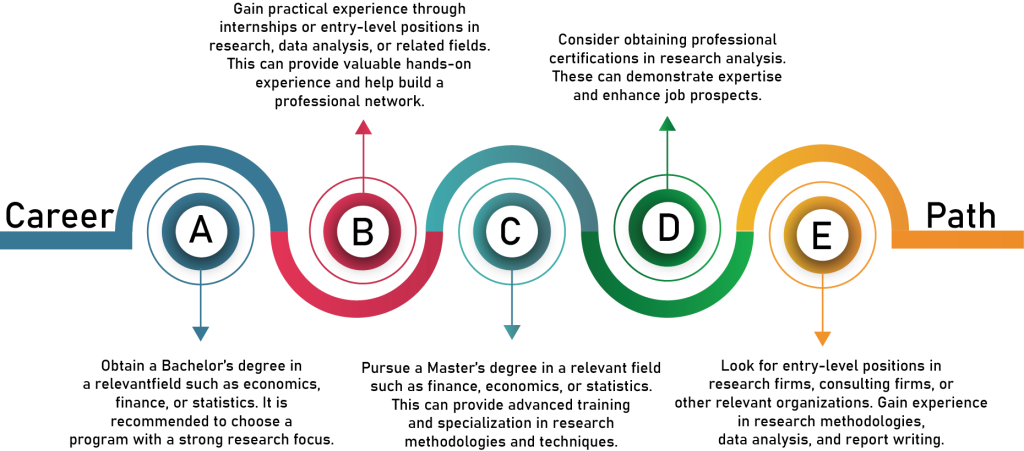A research analyst is a professional who conducts research and analysis on a specific topic or industry. They gather information, evaluate data, and provide insights and recommendations based on their findings. Research analysts typically work in a variety of industries, including finance, healthcare, marketing, and technology.
Work description
The primary responsibility of a research analyst is to conduct in-depth research on a particular subject, using various research methods such as surveys, interviews, and focus groups.
They analyze data, including financial data, market trends, and customer preferences, to identify patterns and make recommendations. They may also monitor and track industry news, regulatory changes, and competitor activity to inform their analysis.
Research analysts work closely with clients or internal stakeholders to understand their research needs and to develop research plans that meet those needs. They may also present their findings to clients, executives, or other stakeholders in a clear and concise manner, often using visual aids such as charts and graphs.
In addition to conducting research and analysis, research analysts may also be responsible for maintaining databases, developing research reports, and staying up-to-date with the latest research methodologies and tools.
High Demand
Opportunities to work in a variety of industries.
Lucrative salaries
High demand for research analysts in many fields.
Opportunities for innovation
Opportunities for professional development and advancement.
Versatility
Ability to develop expertise in a specific area.
Flexibility
Exposure to cutting-edge research methodologies and tools.
Job satisfaction
Good salary and benefits packages.
High stress
Requires advanced education and specialized training.
Long hours
May require long hours and tight deadlines.
Competitive field
May involve repetitive or monotonous tasks.
Constant learning
Results may not always be conclusive or actionable.
Isolation
May require working with complex or sensitive data.
Eye strain and other physical health issues
May require extensive collaboration with stakeholders and clients.
The cost of pursuing a career in research analysis in India can vary based on several factors such as the level of education, location, and institution.
Bachelor’s degree in a relevant field (such as economics, finance, or statistics) from a public university: INR 50,000 – INR 2,00,000 per year. Whereas, Bachelor’s degree from a private institution: INR 1,00,000 – INR 5,00,000 per year.
Master’s degree in a relevant field from a public university: INR 50,000 – INR 2,00,000 per year, and a Master’s degree from a private institution: INR 2,00,000 – INR 10,00,000 per year.
Certification courses in research analysis can range from INR 10,000 to INR 1,00,000, depending on the institution and duration of the course.
Textbooks, study materials, and other supplies can cost INR 5,000 – INR 20,000 per year. Living expenses, including accommodation, food, and transportation, can vary based on the location and individual choices.
[wpcharts type=”horizontalbarchart” bgcolor=”red:gray:yellow,blue:gray:yellow,random:gray:yellow,purple:gray:yellow” min=”0″ legend=”true” titles=”2 year , 5 year” values=”3,7,5,12″]
The earning potential of research analysts in India can vary based on factors such as level of education, work experience, industry, and location.
Entry-level research analysts can earn up to INR 3,00,000 – INR 5,00,000 per year. Mid-level research analysts can earn INR 5,00,000 – INR 10,00,000 per year. Whereas, a senior-level research analyst can earn INR 10,00,000 – INR 20,00,000 per year.
In addition, individuals with advanced education or specialized skills may be able to earn higher salaries. Furthermore, the earning potential may also vary depending on the industry one works in. For example, research analysts working in the finance or consulting industry may earn higher salaries than those working in healthcare or education sectors.
[wpcharts type=”horizontalbarchart” bgcolor=”red:gray:yellow,blue:gray:yellow,random:gray:yellow,purple:gray:yellow” min=”0″ legend=”false” titles=”Entry-Level, Mid-Career, Senior-Level ” values=”5,15,25,35,45,55″]
Strong analytical and critical thinking skills.
Attention to detail and accuracy.
Proficiency in statistics and data analysis software.
Good communication and presentation skills.
Ability to work independently and in a team.
Curiosity and passion for research.
Adaptability and flexibility.
Lack of attention to detail and accuracy.
Poor communication and presentation skills.
Limited proficiency in statistics and data analysis software.
Inability to work independently or in a team.
Lack of curiosity and passion for research.
Resistance to change and adaptation to new methodologies and tools.
Limited exposure to or interest in diverse industries or subject areas.
Work-life balance
The work-life balance of a research analyst can vary depending on the organization, industry, and project requirements. It can be challenging due to long hours, tight deadlines, and a high workload. However, there are also opportunities for flexibility, such as remote work options and flexible schedules. In addition, the work can be intellectually stimulating and rewarding, providing opportunities for professional growth and development. To achieve a healthy work-life balance, time management skills, effective communication with colleagues and managers, and prioritization of personal time and activities are important. Overall, the work-life balance of a research analyst can be demanding but can also offer flexibility and rewarding work experiences. Balancing work and personal life can be challenging, but good time management skills and communication with colleagues and managers can help to achieve a healthy work-life balance.

Contributing to the advancement of knowledge in various fields.
Providing evidence-based insights to inform decision-making in government, business, and social sectors.
The increasing demand for computer engineers has led to job creation and economic growth in various countries, including India.
Improving the efficiency and effectiveness of organizations and industries.
Enhancing transparency and accountability in various sectors.
Overemphasis on profits and market-driven research.
Financial Research Analyst
Conducting research on financial markets, companies, and investments to provide insights to investors and financial institutions.
Market Research Analyst
Conducting research on consumer behavior, market trends, and competition to support marketing strategies and product development.
Data Research Analyst
Collecting, analyzing, and interpreting data to support business decisions and strategies.
Social Research Analyst
Conducting research on social issues and trends to inform policy-making, advocacy, and social change.
Healthcare Research Analyst
Conducting research on healthcare systems, diseases, treatments, and outcomes to support healthcare decision-making and improve patient outcomes.
Conclusion:
In Conclusion, pursuing a Career in Computer Engineering in India requires a Strong Foundation in math and science, a passion for technology, and a willingness to continuously learn and adapt to New Developments in the industry. With competitive salaries, opportunities for career growth, and the potential to make a significant impact on society, computer engineering can be a Rewarding and Fulfilling Career choice for those who are up for the challenge.




